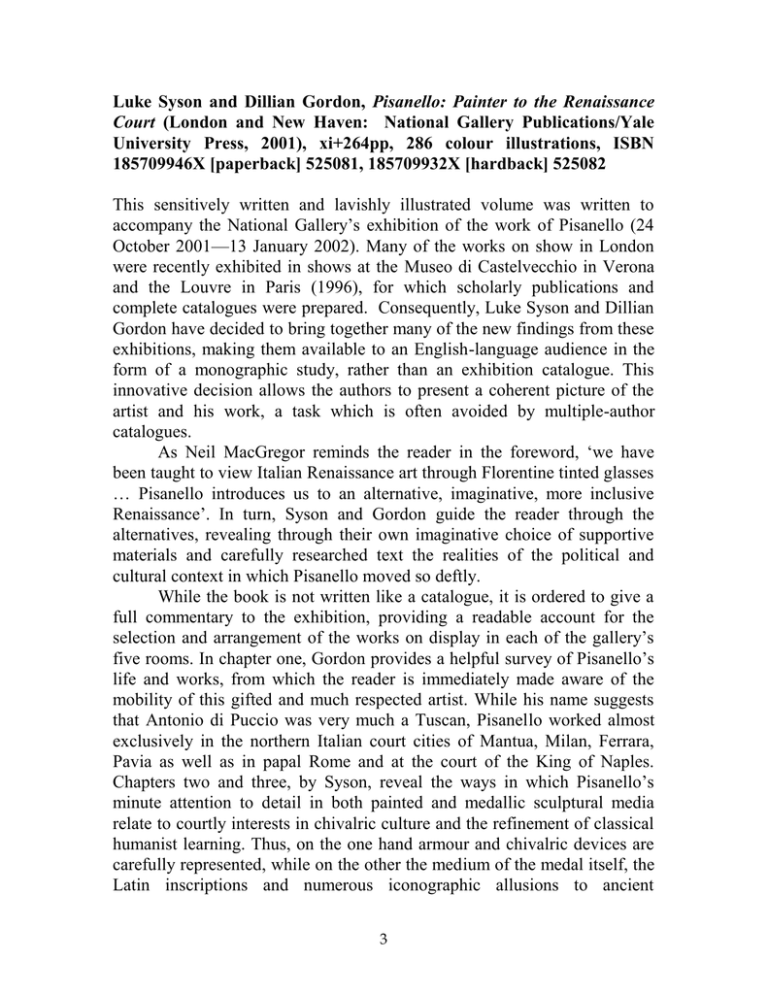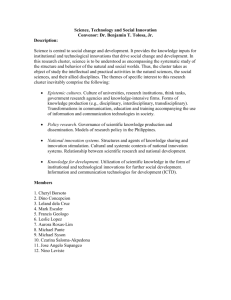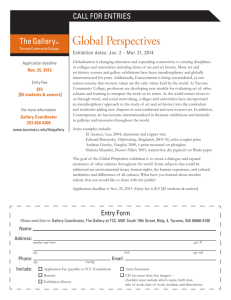Pisanello: Painter to the Renaissance Court
advertisement

Luke Syson and Dillian Gordon, Pisanello: Painter to the Renaissance Court (London and New Haven: National Gallery Publications/Yale University Press, 2001), xi+264pp, 286 colour illustrations, ISBN 185709946X [paperback] 525081, 185709932X [hardback] 525082 This sensitively written and lavishly illustrated volume was written to accompany the National Gallery’s exhibition of the work of Pisanello (24 October 2001—13 January 2002). Many of the works on show in London were recently exhibited in shows at the Museo di Castelvecchio in Verona and the Louvre in Paris (1996), for which scholarly publications and complete catalogues were prepared. Consequently, Luke Syson and Dillian Gordon have decided to bring together many of the new findings from these exhibitions, making them available to an English-language audience in the form of a monographic study, rather than an exhibition catalogue. This innovative decision allows the authors to present a coherent picture of the artist and his work, a task which is often avoided by multiple-author catalogues. As Neil MacGregor reminds the reader in the foreword, ‘we have been taught to view Italian Renaissance art through Florentine tinted glasses … Pisanello introduces us to an alternative, imaginative, more inclusive Renaissance’. In turn, Syson and Gordon guide the reader through the alternatives, revealing through their own imaginative choice of supportive materials and carefully researched text the realities of the political and cultural context in which Pisanello moved so deftly. While the book is not written like a catalogue, it is ordered to give a full commentary to the exhibition, providing a readable account for the selection and arrangement of the works on display in each of the gallery’s five rooms. In chapter one, Gordon provides a helpful survey of Pisanello’s life and works, from which the reader is immediately made aware of the mobility of this gifted and much respected artist. While his name suggests that Antonio di Puccio was very much a Tuscan, Pisanello worked almost exclusively in the northern Italian court cities of Mantua, Milan, Ferrara, Pavia as well as in papal Rome and at the court of the King of Naples. Chapters two and three, by Syson, reveal the ways in which Pisanello’s minute attention to detail in both painted and medallic sculptural media relate to courtly interests in chivalric culture and the refinement of classical humanist learning. Thus, on the one hand armour and chivalric devices are carefully represented, while on the other the medium of the medal itself, the Latin inscriptions and numerous iconographic allusions to ancient 3 prototypes display an all’antica refinement. Pisanello’s intimate knowledge of life at court is not only displayed in these details, however, as we are shown how he ingratiated himself with his employers, improving the profile of Leonello d’Este, for example. Chapter four by Gordon concentrates on the National Gallery’s two panels by Pisanello: The Virgin and Child with Saints Anthony Abbot and George (c. 1435-41) and The Vision of Saint Eustace (c. 1438-42). Uncertainties regarding patronage of these works, so evident when compared with the medals and portraits discussed in previous chapters, are left open to debate as the author concentrates instead on technical observations and a careful analysis of the exquisite animal drawings which were used for the paintings. The final chapter, again by Syson, examines Pisanello’s workshop and inheritance, discussing the use and circulation of drawings among his apprentices and proposing that his influences was perhaps greatest in the field of manuscript illumination. One of the strengths of this book is that it provides a helpful chronology at the outset and then concentrates on thematic groups in the subsequent chapters: an approach which clearly derives from the exhibition format. This allows for subtlety and complexity in the artist’s work to emerge and be discussed; as Syson puts it ‘a single explanation may never have existed: the meaning of an image might be nuanced, shifting, fugitive, a deliberate challenge to beholders …’. Such openness to interpretation lies at the heart of both authors’ approach to Pisanello, just as they argue it had been for his original patrons and viewers. Far more than an exhibition catalogue, this book is the result of a well-managed partnership between specialists in painting and medals, who have been able to build on recent scholarship to produce a monographic study the scope of which goes beyond that of describing the artist, to discussing the whole cultural environment within which he worked. Fabrizio Nevola University of Warwick 4



